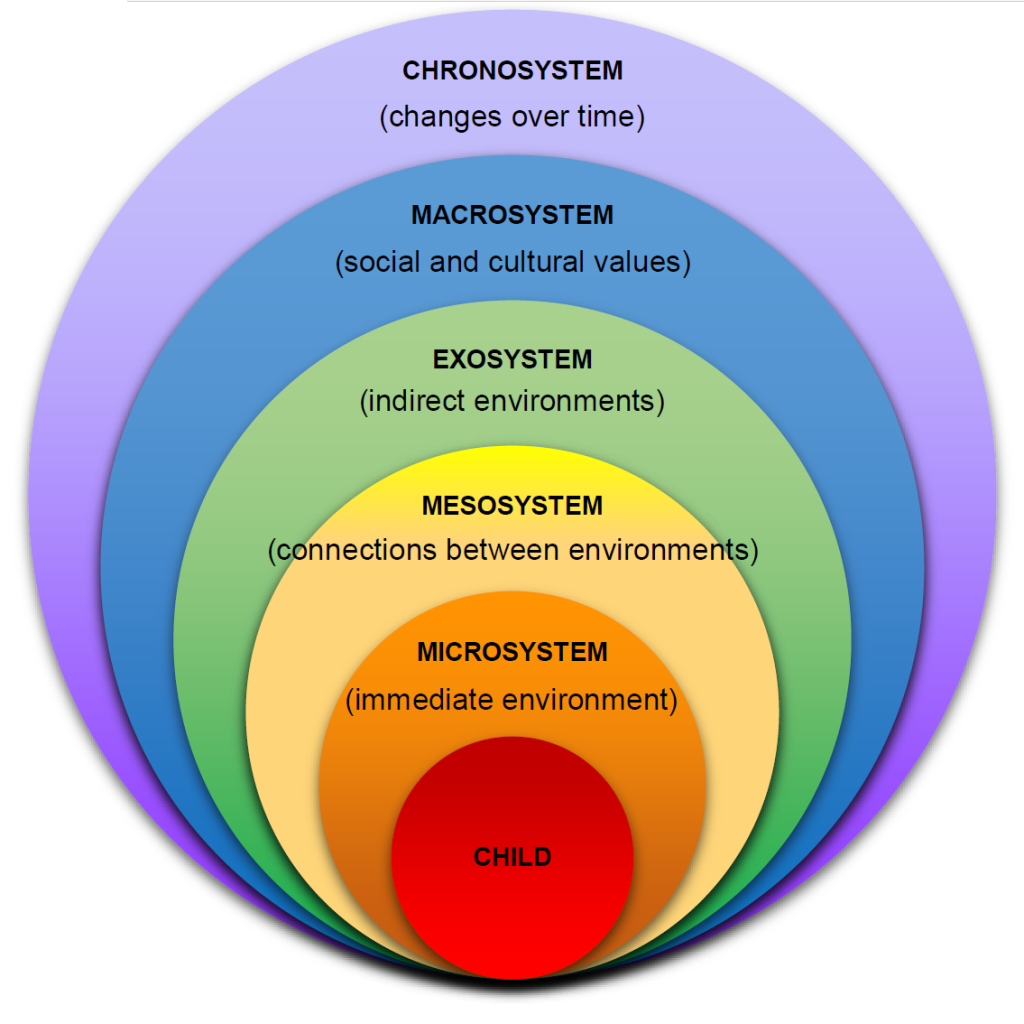Chapter Two: Theorists and Theories of Development
Ecological Theory
Also known as the Human Ecology Theory, Ecological Theory states that human development is influenced by the different types of environmental systems. Formulated by famous psychologist Urie Bronfenbrenner (1917-2005), this theory helps us understand why we may behave differently when we compare our behavior in the presence of our family and our behavior when we are in school or at work. The ecological systems theory holds that we encounter different environments throughout our lifespan that may influence our behavior in varying degrees. These systems include the microsystem, the mesosystem, the exosystem, the macrosystem, and the chronosystem, and are usually depicted by nesting spheres of influence.

The microsystem is the setting in which we have direct social interactions with people and social agents. Family, friends, classmates, teachers, neighbors and other people with whom we have direct contact are included in the microsystem. The theory states that we are not simply recipients of experiences, rather we are contributing to the construction of such environments; we have influence over the people and systems in our lives, as they have influence over us.
The mesosystem involves the relationships between the microsystems in one’s life. This means that your family experience may be related to your school experience. For example, if a child is neglected by his parents, he may have a low chance of developing a positive attitude toward his teachers. Also, this child may feel awkward in the presence of peers and may resort to withdrawal from a group of classmates.
The exosystem is a system of indirect influences and includes systems that have influence but are those with which a child doesn’t have any direct contact. For example, a parent who has been demoted at work may bring home feelings of frustration or anger—the child may never have any interaction with the parent’s boss, but that boss may, nonetheless, have influence over how that parent interacts with the child. Ecological Theory
The macrosystem setting is the actual culture of an individual. These cultural contexts include the socioeconomic status of a child, his/her ethnicity or race, and the specific society in which a child lives.
The chronosystem adds the dimension of time and includes the transitions and shifts in one’s lifespan. One classic example of this is how divorce, as a major life transition, may affect not only the couple’s relationship but also their children’s behavior. According to the majority of research, children are negatively affected in the first year after divorce. The next years after the divorce might reveal that the interaction within the family becomes more stable and agreeable (Berk, 2017; Crain, 2011; Santrock, 2013).
Educational Implications
Bronfenbrenner looked at patterns of development across time as well as the interactions between the child and the environment. The educational implications of his model include the social and political policies and practices affecting children, families, and caregiving. As teachers and educators strive to become evidence-based practitioners, the goal then becomes to identify those factors such as caregivers, family, peers, culture, historical perspectives that influence students’ learning and development.
In that regard, Bronfenbrenner‘s theory encourages much consideration of what constitutes supportive interactions in fostering development. It goes beyond identifying what might influence development, and, more importantly, assists in considering how and why it influences development. Furthermore, Bronfenbrenner’s theory also assists in considering how an interaction might be added or taken away or improved to foster development and, especially, how a face-to-face interaction between a developing individual and an agent within his or her environment might be changed. Although Bronfenbrenner’s multi-system model has value in identifying the resources that influence development, it is more likely of value in assisting consideration of how those resources might be used. Inherent within this idea is the emphasis Bronfenbrenner places on the understanding that interactions nearest to the child have the greatest influence on the development of that child. The ecological systems theory has also become an important foundation for other theorists’ work. (Sincero, 2012)
Criticisms of Educational Theory
A criticism of Bronfenbrenner has been that the model focuses too much on the biological and cognitive aspects of human development, but not much on the socio-emotional aspect of human development. A more comprehensive view of human development, one with the domains of human development at the center, has been developed. This ecological model is called the Integrated Ecological Systems Framework (Sincero, 2012).
Media Attributions
- Ecological-Theory-1024×1024-1 © Deirdre Budzyna via. ROTEL is licensed under a CC BY-SA (Attribution ShareAlike) license
states that human development is influenced by the different types of environmental systems
the setting in which we have direct social interactions with people and social agents
the relationships between the microsystems in one's life
indirect influences
the culture of an individual
the dimension of time; the transitions and shifts in one's lifespan

